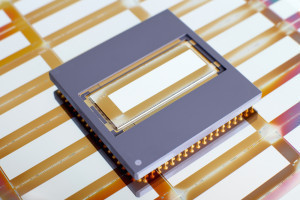The Fraunhofer Institute for Photonic Microsystems (IPMS) uses optical microsystems to control light quickly and with high resolution. By using small, movable mirrors, the photonic systems can modulate light and generate precise images and structures. The researchers are implementing 1-axis and 2-axis tilting mirrors as well as vertical mirrors, monolithically integrated on so-called CMOS backplanes.
The area light modulators developed at the institute consist of arrays of micromirrors on semiconductor chips, with the number of mirrors varying from a few hundred to several million depending on the application. In most cases, this requires a highly integrated application-specific electronic circuit as the basis for the component architecture in order to enable individual analog deflection of each micromirror. The institute also develops the electronics and software to control the mirror array. Depending on the application, the individual mirrors can be tilted or deflected vertically to create a surface pattern, e.g. to image defined structures.
Use of tilting mirror arrays
High-resolution tilting mirror arrays with up to 2.2 million individual mirrors can be used as dynamic programmable masks for optical microlithography in the ultraviolet spectral range. The mirror dimensions are 10 μm or larger. By tilting the micromirrors, the structural information is transferred to a high-resolution photoresist at a high frame rate. Other areas of application include semiconductor inspection and measurement technology as well as perspective laser printing, marking and material processing.
Use of perpendicular mirror arrays
 Mirror array with one million individual mirrors; Image: Fraunhofer IPMSSerial mirror arrayscan be used, for example, for wavefront control in adaptive optical systems. These systems can correct wavefront interference in a wide spectral range and thus improve image quality. Compared to alternative liquid crystal-based technologies, micromirrors enable significantly higher modulation frequencies. The capabilities of the components are of particular interest in the fields of holography, astronomy and microscopy as well as in spatial and temporal laser beam and pulse shaping.
Mirror array with one million individual mirrors; Image: Fraunhofer IPMSSerial mirror arrayscan be used, for example, for wavefront control in adaptive optical systems. These systems can correct wavefront interference in a wide spectral range and thus improve image quality. Compared to alternative liquid crystal-based technologies, micromirrors enable significantly higher modulation frequencies. The capabilities of the components are of particular interest in the fields of holography, astronomy and microscopy as well as in spatial and temporal laser beam and pulse shaping.
Current development projects
One of the institute's developments is a CMOS-integrated micromirror array with two tilting axes per mirror and an associated technology platform. The component consists of 512 x 320 individually addressable mirrors with a pixel size of 48 μm. The optical operating principle is based on a spatially resolved redistribution of light. This can be used to redirect light beams or to generate and control 2D intensity profiles and patterns with variable intensity. Since light is redistributed instead of masked, a higher light yield is possible. This innovation opens up new possibilities in the semiconductor industry, in microscopy, particularly for biomedical applications, and in laser material processing.
Another development of the institute is a matrix component with around one million micromirrors with an optically active area of 33 × 8 mm². The matrix can be reprogrammed with a frequency of 2 kHz, whereby each torsionally mounted micromirror is provided with an individual deflection. Based on this component configuration, application-specific customer requirements can be taken into account for further developments. A customer evaluation kit is available for researching new applications. The kit consists of a matrix with 256 x 256 individual mirrors (64 k), control electronics and software. The scientists are currently working on the implementation of a 64k platform for the production of countersunk mirrors.


